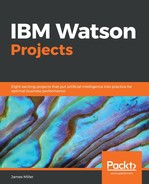In Chapter 7, we concentrated on the concept of personalized recommendations and the use of Watson Analytics to create specialized plans through conversational behaviors found within data. The objective was to create an individualized plan based upon a type of user's prior activities and characteristics found within a designated pool of data.
Key takeaways
- A personalized recommendation means to present or offer someone only those options for a particular situation that have the most probability of being chosen by that individual.
- Recommendations are characteristically made based on experienced user behavior such as user purchases, page views, clicks, and even items a user has added to a (shopping) cart but perhaps hasn't actually purchased.
- It is common to come across product recommendation engines which utilize Artificial Intelligence to enhance shopping experiences for customers of online stores.
- A product recommendation engine is designed to give product cues to a user that are visually related to current product choices.
- It makes sense to use Watson Analytics to analyze user behavior data and then provide recommendations based upon Watson's ability to identify predictors with the highest prediction strength.
- Predictive strength measures how well a predictor variable accurately predicts a target. You use predictive strength to compare the various predictors within data and it is presented as a percentage.
- The fundamental statistical test that determines predictive strength depends on the measurement level of the target. For categorical targets, predictive strength is the proportion of correct classifications.
- Watson Analytics project cadence involves conducting a brief dialog on the objective(s) of the project then having a high-level peek at the actual raw data to be used in the project.
- Before loading the data into IBM Watson Analytics, it is sometimes advantageous to perform some data preparation—to ensure that all of the analyses we'll perform are as accurate as possible.
- Some data preparation tasks include: removing filters and hidden rows or columns, removing total lines/columns as well as nested lines and columns, and verifying that all columns have names or titles.
- In Watson Analytics Refine, it is easy to test data quality column by column.
- To narrow down the data in a file, you can use Refine filters. Once you have added a filter, Watson Analytics adds a blue line or blue dashes to the column name indicating that the data in that column is filtered. A brief description of the filter also appears on the column name.
- Once you make refinements to a dataset and save it, Watson Analytics will append the word Refinement to the end of the original dataset name and the original dataset is not changed in any way.
- IBM Watson Analytics uses questions rather than SQL commands to generate a list of starting points that can be used to create visualizations that meet your needs.
- At the bottom of each page of an Exploration, the current page is indicated by a solid circle icon. To move to another page, you click a different circle or view all pages at the same time by using the tile icon.
- After performing an exploration, you should have identified the data points within the data that are of interest to your project's objectives and have a reasonable idea of what to create a prediction on and what the best or strongest predictors might be.
- You can create and compare multiple visualizations during an exploration using bar charts, bubble charts, tree maps, and other visualization types, which can be saved and reused with Assemble; you can also the email the visualizations as images, presentations, and Adobe PDF files.
- Project prediction targets are the fields of interest in a prediction and are influenced by other fields in the data. The Watson Analytics Predict capability defines default targets and field properties for you.
- Across the top of the Top Predictors page is the summary ribbon of the predictive model generated by Watson Analytics. The summary ribbon includes thumbnail images showing Targets—thumbnail lists of the targets defined in the model, Data Quality (Score)—measuring the degree in which the data used in the model is appropriate to be utilized for predictive analysis, Analysis Details—showing the total number of columns in the data that were considered in the predictive analysis as well as the number of those inputs that could potentially affect the target, Top Field Associations giving the result of the analysis, and Model Highlights indicating what the predictive target is and proving a brief summary of the model results.
- When you create a new prediction in Watson Analytics, the prediction opens automatically so you can view it. While you are viewing a prediction, you can see a summary of the most important insights in your data and explore specific fields in detail.
- The spiral visualization or the predictive bullseye on the Top Predictors page shows the top predictors in color, with other found predictors in gray. The closer the predictor is to the center of the spiral or bullseye, the stronger that predictor is.
- You can use the Assemble capability to convey/share the analysis and insights discovered in Predict (and also Explore) by adding them to the collection by clicking the Collect icon.
- Using Assemble, you can view collected Assets, drag and drop them onto a template, and then name and save them.
